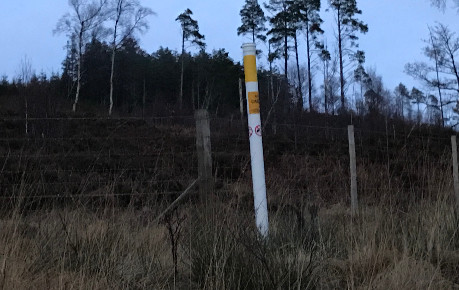Friday 19th January 2018, 10:33am
Forestry Commission Scotland may soon change regulations which have meant white, two-metre-high poles being erected along the line of popular walking routes in remote parts of the highlands.
The marker poles are erected to mark the track of underground power cables associated with hydro schemes.
A mountaineering Scotland member raised concerns about the visual intrusion of the marker poles and, contacting the developer, was told that they were insisted on by Forestry Commission Scotland (FCS).
Our member, who stressed that he was in favour of small scale hydro schemes, said he had been pleased to see power cables being buried as part of the construction of several schemes in the Loch Arkaig area, but was surprised to discover on his last visit “hundreds of tall white posts marking the line of the cable. They seem to me to completely defeat the burial of the cable and are probably as noticeable as wooden pylons every two hundred metres, or perhaps even more so.”
He added that another visit to Craig near Achnashellach revealed the same type of posts.
“It seems a great shame that the efforts to mitigate the environmental impact of these worthwhile schemes have been negated by the posts. Even cutting the posts down to protrude half a metre would be beneficial without compromising any duty of care.”
The company erecting the poles was Green Highland Renewables, which said it agreed the poles were obtrusive and had asked FCS if smaller ones could be used, but without success.
Ian Cartwright, Chief Operations Officer of Green Highland Renewables, said: “Until FCS policy is relaxed we are required by the conditions of the lease to mark underground services with this form of marker.”
He added: “In cases where the ground does not belong to FCS, our approach to marking services is by the installation of small concrete posts or wooden fenceposts, similar to those used by Scottish Water. We feel these are unobtrusive and fulfil the requirement to mark service routes.”
In discussions with FCS Mountaineering Scotland Chief Executive Officer David Gibson said: “We recognise that underground cables have to be marked for health and safety reasons, however, while the white poles would be highly appropriate for use within a heavily forested environment, they seem to be out of place alongside tracks where many people will take access for recreational purposes, and where the use of a less intrusive marker could be provided at no risk to the safety of FCS operatives.”
After the talks a spokesperson for Forest Enterprise Scotland said: “The poles are a standard health and safety measure and are used to mark where underground power cables, gas mains and water pipes could be located. They essentially ensure that anyone carrying out works in the area is aware that these are areas to keep away from.
“We are currently reviewing our policy to assess its suitability for all landscapes without compromising safety.”

One of the offending marker poles.